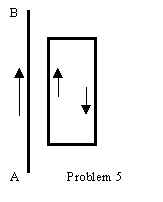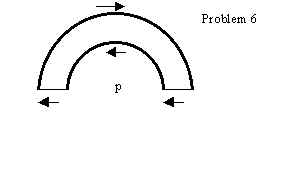

Workshop module 7 - Physics 114, Spring 2000
1:
Break up into groups of two. Each group of two should come up with three different drawings of a positive, negative, or neutral charge moving with a velocity, v, through a magnetic field B. Label ONLY the charge (+,-,0) and the velocity vector (which could have magnitude 0) and the B field vector (which could have a magnitude 0) at a given instant. The directions of the velocity vector and B field vector are arbitrary, though it will be best if you allow the vectors to be in the plane of the paper or perpendicular to the paper. Now each group should go to the board and reproduce their drawings there. The class should discuss and agree on the direction for the magnetic force on each of the moving charges. Try to be tricky with at least one of your three drawings! If, for some reason there are too few people in your workshop to make a reasonable number of examples … each person should make up three … or your TA will join in a make up a few.2: Back into your groups of two … or different groups if you are so inclined. Each group should draw two straight-line current segments (in the plane of the paper or perpendicular to the paper) in a magnetic field (again, the B vector should be in the plane of the paper or perpendicular to the paper). The current can be either moving positive or negative charge, but you must specify which. Make more than two drawings if you are in a small workshop. Again, take turns showing the workshop your drawings. The group should discuss and agree on the direction of the magnetic force on each current segment.
3: Back into your groups of two! Do the same thing as above … but, this time draw current loops and do not put in a magnetic field vector. Your loops can be perpendicular to the paper and carry either sign of charge either direction. Now when you show your drawings to the rest of the workshop, the group should agree on the direction of the magnetic field generated by each current loop. What is the direction of the magnetic field on the inside and the outside of the loop?
4: A straight piece of conducting wire of mass M and length L is placed on a frictionless incline tilted at an angle q from the horizontal. The length of the wire is perpendicular to the direction of the incline. There is a uniform, vertical magnetic field B at all points. To keep the wire from sliding down the incline, a voltage source is attached to the ends of the wire. Make a sketch of the problem and appropriate free body diagrams. Determine the magnitude and direction of the current in the wire that will cause the wire to remain at rest (i.e., not slide down the incline).
5: The long straight wire AB in the figure below carries a current of 14.0 A. the rectangular loop whose long edges are parallel to the wire carries a current of 5.00 A. Find the magnitude and direction of the net force exerted on the loop by the magnetic field of the wire. The distance from the straight wire to the nearest edge of the loop is 2.6 cm. The distance fromt eh straight wire to the far edge of the loop is 10.0 cm. The long side of the loop is 20.0 cm.
6: The wire semicircles in the figure below have radii a and b. Calculate the net mangetic field (magnitude and direction) at the point P (at the center of the loops) due to the current I passing through the loop in the direction shown.

